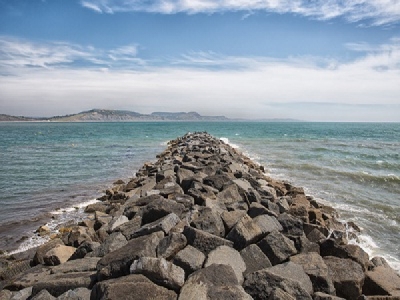
Posted on September 11, 2016
By Rob Ward, JOC.com
After devastating flooding forced the closure of South America’s largest port and cast doubts on the viability of dredging plans so it can handle mega-ships, one consultant thinks he has come up with a solution.
Currently the port of Santos has no breakwater, but if one were constructed, then dredging to 17 meters (56 feet) could take place without exacerbating high tides that cause damaging beach erosion, according to Robert Grantham, the owner of the Itajai-based maritime consultancy ShipConsult. Some have argued that dredging would make the tides worse because the deeper the harbor, the stronger the currents.
Santos presently has a draft of 13.9 meters at low tide, and a plan called Santos 17 to dredge to 17 meters before the end of 2017 now seems a pipe dream after the recent inundations. The largest ships Santos can now handle have capacities of 10,000 twenty-foot-equivalent units, but at 17 meters the port would be able to handle the largest ships afloat.
“The high sea levels and flooding occurred all along the Brazilian coastline, but most damage was caused in Santos,” said Grantham, who has worked for many years in the river port of Itajai, where flooding and strong currents have been a regular problem. “But if they had a breakwater, I think these beaches in Santos would be protected.”
Grantham served as commercial director at Itajai for more than five years, and has also worked for a longer time as Brazil country manager for Cosco Container Lines.
“When I started in Itajai 25 years ago the port only had eight meters and all the experts said that if we went to 10 meters the river banks would collapse, but they didn’t,” he said. “Then they said the same if we went to 11, and 12 and then finally 14 meters, but there was no collapsing on each occasion. Now, they are lengthening the turning basin in Itajai.”
Contrary to the claims of collapses, the beach in Itajai began to grow as water flow sped up through the channel, and the same thing happened in Rio Grande do Sul in the far south of the country, he said.
The University of Sao Paulo is carrying out modeling and testing of the Santos channel to determine scenarios that might allow a greater draft, which Grantham warned would be necessary if Santos were to become a key east coast South America transshipment hub.
“I know that Maersk Line is considering a service from the Far East to the US via South Africa and transshipping ECSA cargo at Pecem (in the north of Brazil) and if lots of carriers started doing this, that would be a hard blow for Santos to take,” Grantham told told JOC.com. “However, there is not much local cargo for the north of Brazil, so transshipping huge volumes of cargo would be unlikely.”
Source: JOC.com





